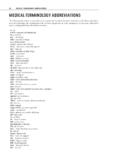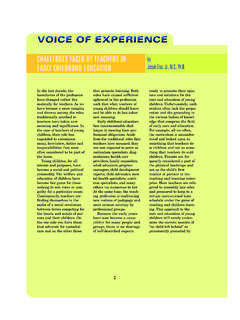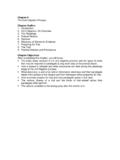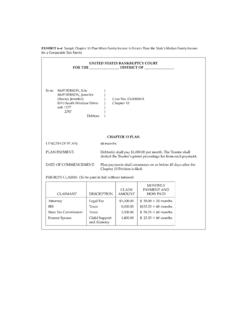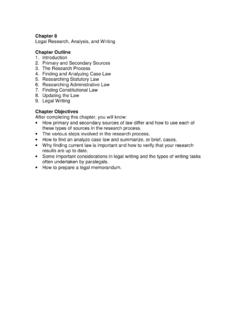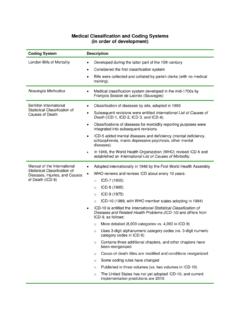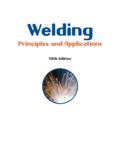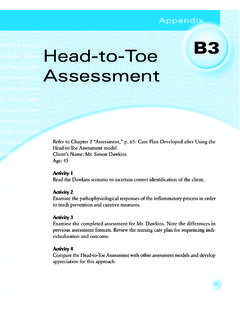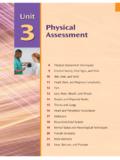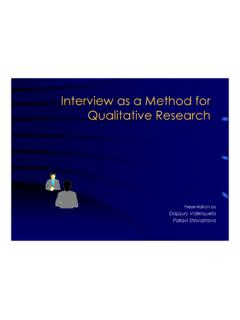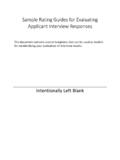Transcription of Chapter 7 Conducting Interviews and Investigations
1 Chapter 7 conducting interviews and investigations Chapter Outline 1. Introduction 2. Planning the interview 3. Interviewing Skills 4. Interviewing Clients 5. Interviewing Witnesses 6. Planning and Conducting Investigations Chapter Objectives After completing this Chapter , you will know: How to prepare for an interview and the kinds of skills employed during the interviewing process. The common types of client Interviews paralegals may conduct and the different types of witnesses paralegals may need to interview during a preliminary investigation . How to create an investigation plan. The variety of sources that you can use to locate information or witnesses. Rules governing the types of evidence that are admissible in court. How to summarize your investigation results. Chapter 7 Conducting Interviews and investigation Chapter Outline I. INTRODUCTION A. Paralegals frequently interview clients.
2 B. How the paralegal relates to the client has an important effect on the client s attitude toward the firm and the attorney. II. PLANNING THE interview A. Know What Information You Want to Obtain i. Preprinted interview Forms 1. Many law firms have created preprinted or computerized forms indicating the kinds of information that should be gathered. 2. Using preprinted forms helps to ensure that all essential information will be obtained. ii. Remain Flexible 1. Prepared questions and preprinted forms should only be used as guidelines. 2. Do not rigidly follow the forms; paralegals must interact with the interviewee. iii. Plan to Ask Follow-Up Questions 1. Ask for details and clarification after the interviewee has made a statement. 2. Find out who, what, when, where, and how. iv. Recording the interview 1. Obtain permission to tape-record the interview from both your supervising attorney and the person being interviewed.
3 2. Advantages to tape-recording the interview are having a record of the interview and the ability for other members of the legal team to listen to the tape. 3. A disadvantage to tape-recording the interview is that clients and witnesses may feel uncomfortable and less willing to disclose information freely. Interesting Interviews Adapting to various personalities in interviewing clients and witnesses is as important as adapting to various personalities within the law office. Use your interpersonal skills and increase your patience for, and tolerance of, those different from you. Remember, you have a job to do. III. INTERVIEWING SKILLS A. Interpersonal Skills i. Avoid using legal terms that will not be clearly understood by the interviewee. ii. Be sure to put the individual at ease as quickly as possible. B. Questioning Skills i. Remain objective at all times and gather as much relevant, factual material as possible.
4 Ii. Use questioning techniques to prompt interviewees to communicate the information needed. 1. Open-Ended Questions a. The open-ended question is a broad, exploratory question that invites any number of possible responses. b. These questions are useful for interviewing clients or friendly witnesses. 2. Closed-Ended Questions a. The closed-ended question is intended to elicit a yes or a no response. b. These questions may be useful for adverse witnesses who are reluctant to volunteer information. 3. Leading Questions a. The leading question is one that suggests the answer to the question to the listener. b. Leading questions may lead to distorted answers because the client or witness may tailor the answer to fit his perception of what the interviewer wants to know. 4. Hypothetical Questions a. The hypothetical question is frequently used with the expert witness. b. Hypothetical questions are questions based on hypothesis, conjecture, or fiction.
5 C. Listening Skills i. Passive Listening 1. Passive listening techniques are verbal and non-verbal cues that encourage the speaker to continue. ii. Active Listening 1. Active listening involves providing appropriate feedback to show that you understand what is being said. a. Reflecting Back. This is summarizing your impression of what the interviewee said. b. Controlling the Flow of the interview . The interviewer puts the person s statement into the context of the larger picture and facilitates a smooth transition between interview topics. IV. INTERVIEWING CLIENTS A. The Initial Client interview i. The initial interview is usually conducted by the attorney but is often attended by the paralegal. ii. The paralegal must indicate their non-attorney status to the client if the attorney does not do so. iii. The paralegal is ordinarily responsible for documenting and summarizing the results of the initial session.
6 B. Subsequent Client Interviews i. If the firm accepts the case, a subsequent interview may be scheduled to gather additional information. ii. The subsequent interview is often handled by the paralegal alone. C. The Informational interview i. The informational interview is also often handled by the paralegal. ii. In this interview , the paralegal may explain trial procedures to the client and help the client understanding why certain proceedings are taking place. D. Summarizing the interview i. The paralegal should summarize the interview as soon as possible after it is concluded. ii. The interview should be summarized in a written memorandum. V. INTERVIEWING WITNESSES A. Types of Witnesses i. A major difference between interviewing witnesses and clients is that witnesses may not always be friendly to the client s position. ii. Expert Witnesses 1. An expert witness is an individual who has professional training in a given area and can give an educated opinion on facts and issues related to the case.
7 Iii. Lay Witnesses 1. A lay witness is an ordinary witness who has factual information about an event. iv. Eyewitnesses 1. An eyewitness is one who has observed an incident firsthand. v. Friendly Witnesses 1. A friendly witness is one who is biased against the client s adversary or sympathetic toward the client s position. vi. Hostile Witnesses 1. The hostile witness is prejudiced against the client and often has an interest in the outcome of the case that is adverse to the client s interest. B. Questioning Witnesses i. Phrase questions so that they lead to the most complete answer possible. ii. Find out exactly what the witness observed, in his own words. C. Checking a Witness s Qualifications i. Competence 1. Lay witnesses are competent only if they actually saw, heard, or perceived the events in some way. 2. Expert witnesses are qualified only if they possess special knowledge, skill, experience, training, or education.
8 Ii. Credibility 1. Paralegals investigating the case should inquire into any matters that tend to show whether or not a witness is honest. iii. Bias 1. The paralegal should investigate whether the witness has an interest in the claim being investigated that would tend to make his testimony prejudicial. D. Winding Up the interview i. At the interview s conclusion, the paralegal should ask the witness if there is anything else he would like to add to his statement. ii. The paralegal should verify the witness s complete address, telephone number, and other important information. E. Witness Statements i. After the interview , the paralegal should prepare a memo to the supervising attorney. ii. The memo should include the paralegal s evaluation of the witness s credibility and any relevant non-verbal communication. iii. A witness statement is a written document setting forth what the witness said during the interview .
9 The witness is given an opportunity to review the contents of the statement and verify in writing that the statement is correct. VI. PLANNING AND Conducting Investigations . A. Where Do You Start? i. Creating an investigation Plan 1. An investigation plan is a step-by-step list of tasks that the paralegal plans to undertake to verify or obtain factual information relating to a legal problem. 2. The paralegal should make sure that the supervising attorney approves the investigation plan. ii. Contacting the Police Department 1. One of the first steps should be to contact the police department to look at the accident report, view any photographs, obtain the names of witnesses, and talk to the investigating officer. iii. Contacting and Interviewing Witnesses 1. Contact and interview any known witnesses and document their descriptions of what took place. 2. If a witness has retained an attorney, all communications must be through the attorney.
10 Iv. Obtaining Medical and Employment Records 1. To obtain information to justify a claim for damages, the paralegal needs to obtain copies of the injured party s medical and employment records. v. Contacting the National Weather Service 1. Weather conditions at the time of an accident have an important bearing on the case. 2. Contact the National Weather Service to determine the conditions at the time of the accident. vi. Obtaining Vehicle Title and Registration Records 1. Obtain title and registration records from the state department of motor vehicles, or the secretary of state s office. 2. Call the relevant office in advance to find out what procedures should be followed to obtain this information. vii. Contacting the Insurance Company 1. Contact the insurance company to find out the insurance coverage and limits under the policy. Investigating the Factual Findings investigation requires all the skills you have read about: organizational, interpersonal, communication, and analytical.

